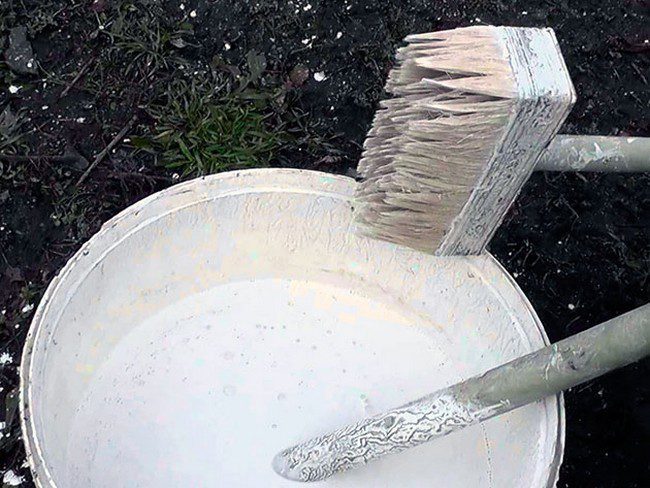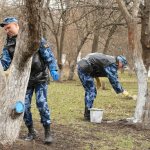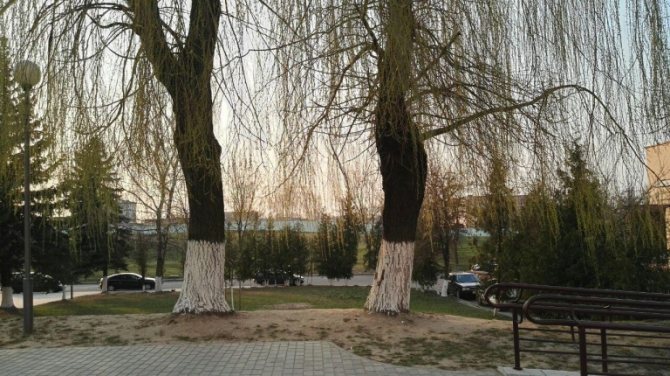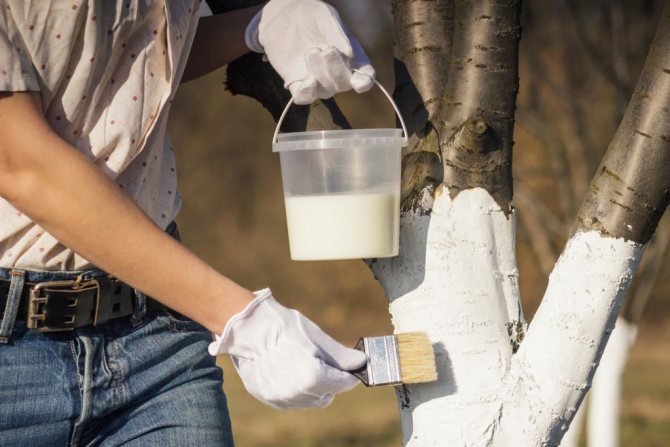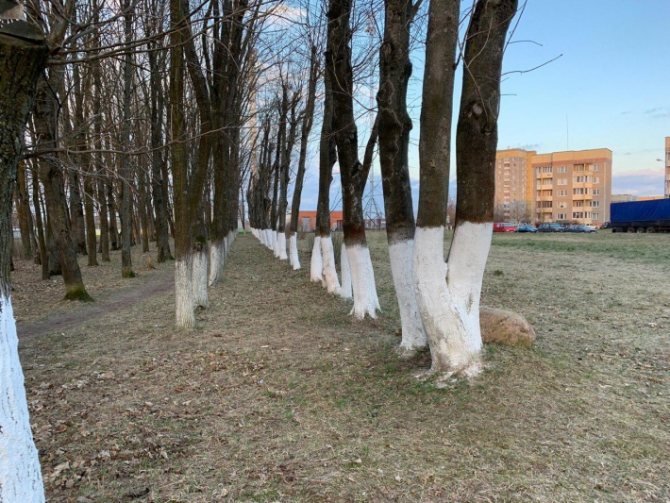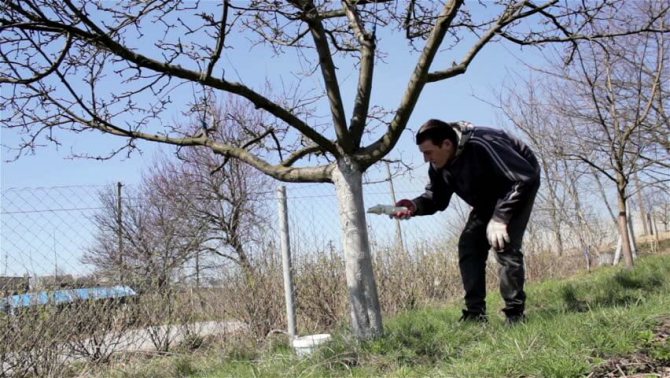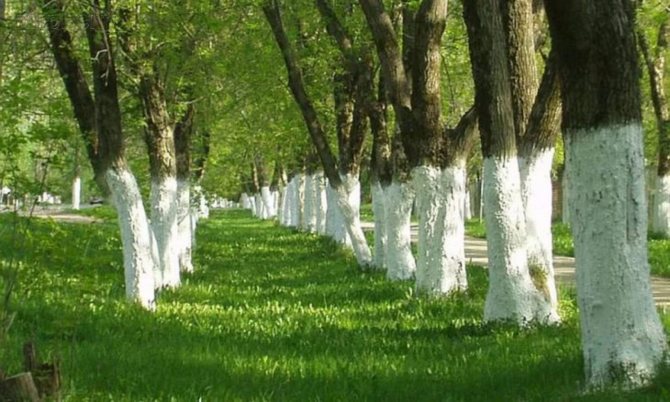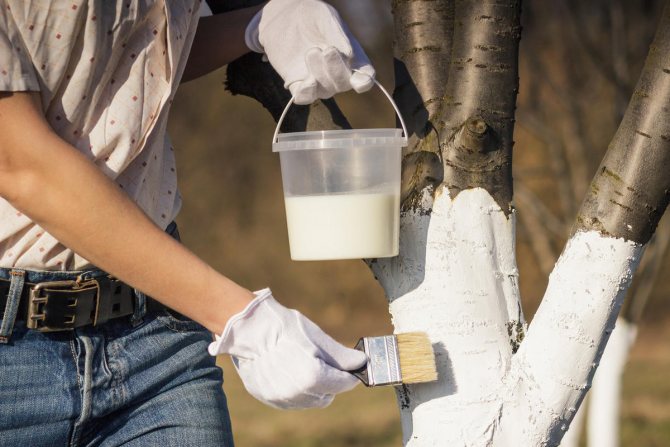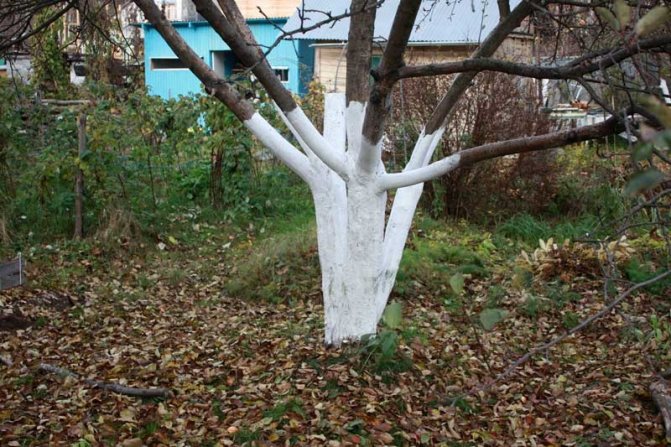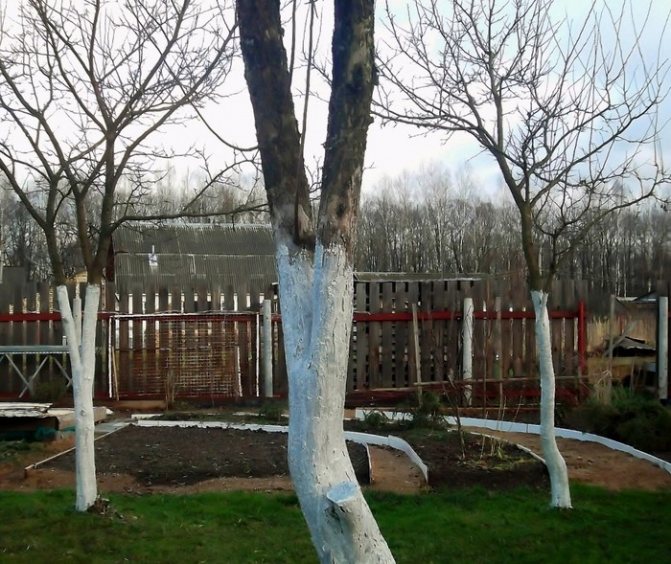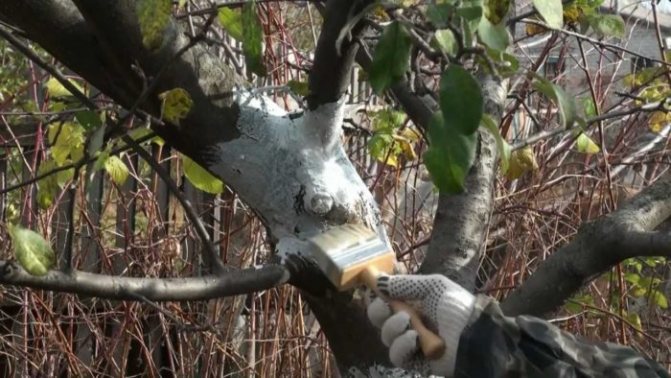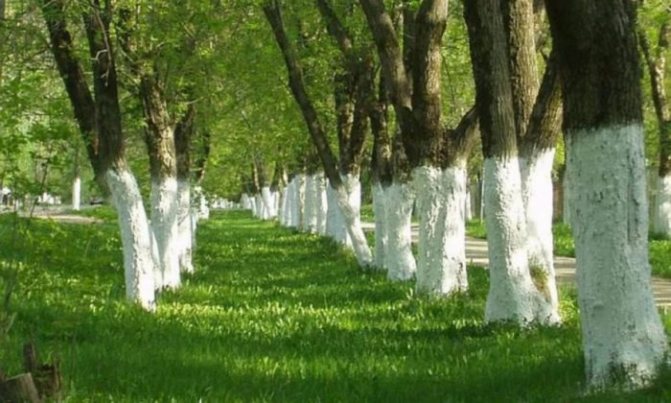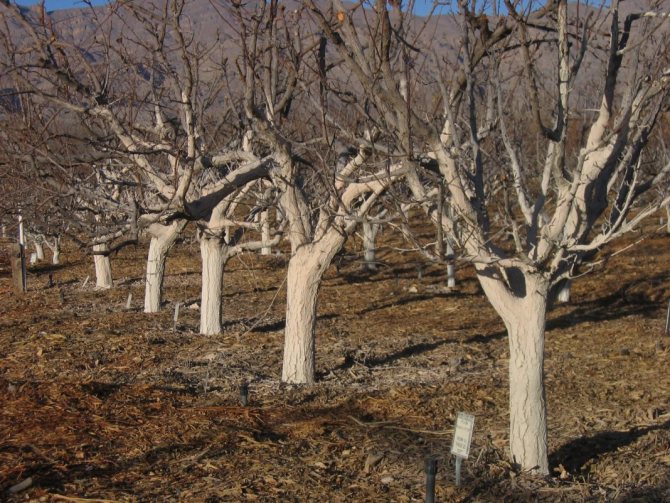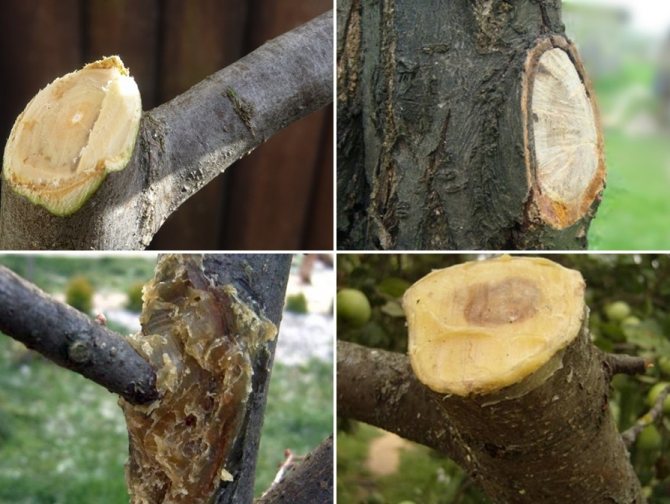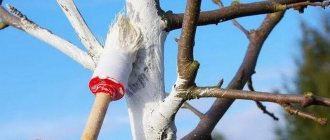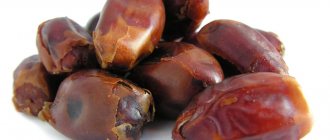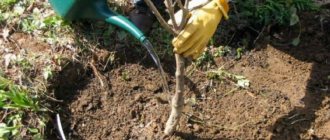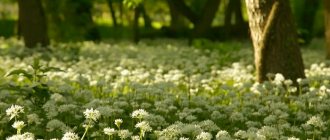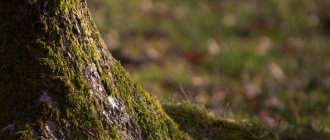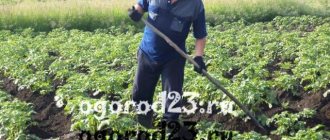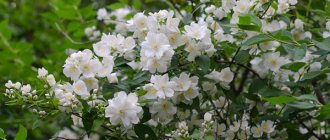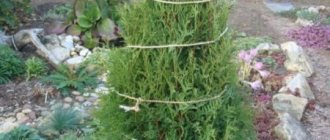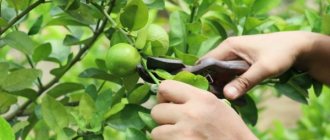Every year public utilities whitewash trees by order of officials. This is one of the most ineffective occupations for the city, on which budget money and thousands of man-hours are spent.
Photo: Media Ryazan
Trees began to be painted in cities during the war so that you could drive at night without headlights. Arkady Gershman writes about this. Artemy Lebedev also writes about this, quoting another author:
“The tradition of painting trees and curbs white began in World War II, this was done along transport arteries so that convoys could move in the dark with their headlights off - so convoys were invisible to enemy aircraft, but at the same time had a reference point for movement. This phenomenon had nothing to do with the aesthetics and decoration of cities. "
However, after the war, the practice of whitewashing took root and became another element of the Soviet school of landscaping, along with cleaning foliage from lawns, painting fences, whitewashing curbs and, in especially neglected cases, whitewashing concrete pillars. Without all this, officials considered the city "unkempt."
These practices have not outlived their usefulness so far - it is more convenient for officials to whitewash the trees, instead of mending sidewalks, creating a barrier-free environment and making the city comfortable.
Remember: if trees are thoughtlessly whitewashed in your city, it means that city officials have contracted a disease "to make it look more beautiful" or are simulating a violent activity: you can report on thousands of whitewashed trees, and not engage in real improvement.
Whitewashing pleases not the trees, but the uneducated soul of the utility.
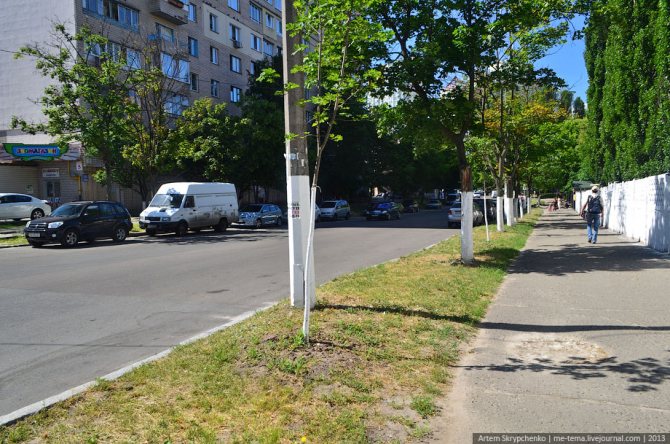
A well-groomed city according to a post-Soviet official. Photo: Kyivsitipproject
Why whitewash trees
If the autumn whitewashing is performed in order to prevent the formation of cracks and frost cracks in the bark of trees and shrubs in winter and to destroy pathogens and pests gathered in the bark, then whitewashing trees in spring is carried out to protect their boles and skeletal branches from burns, since at this time the sun is very active, and there is still no foliage on the plants that could protect the bark from overheating.
In addition, whitewashing in spring is a preventive measure against pathogens and pests, which nevertheless managed to survive the winter in cracks in the bark and in the upper layer of the soil.
That is why trees are whitened at least twice a year - in autumn and spring.
- Norway maple: description of varieties, planting and care
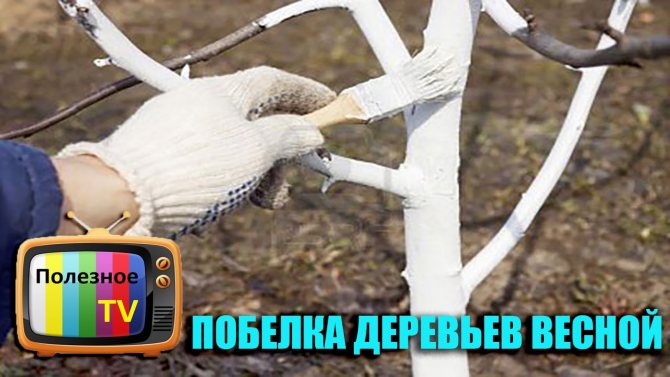

Why don't they whitewash everything abroad
Whitewashing of trees is not widespread in the world. In addition to the post-Soviet countries, it is universally carried away only in African countries. They think it's beautiful.


Democratic Republic of the Congo. Photo by Artemy Lebedev
In developed countries, lime is sometimes used to protect young tree shoots from the sun, but more often they use tree trunk wrapping for this. Trees are not whitened against insects, but treated with special agents.
Whitewashing spoils the appearance of the city. It interferes with the natural appearance of trees, adds them a feature not found in natural conditions - a contrasting part of the trunk.
Cities look better with unbleached trees:
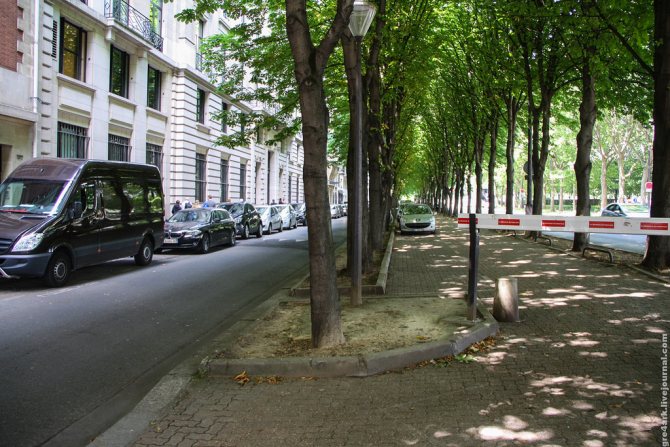

Paris. Photo by Arkady Gershman


Netherlands, photo by Ilya Varlamov


Berlin, photo by Ilya Varlamov
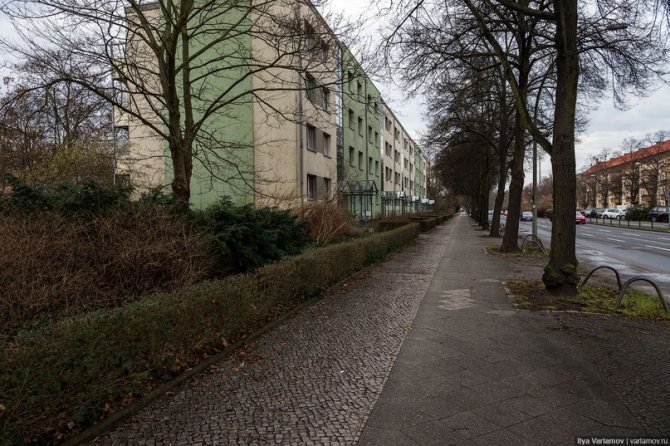

Berlin, photo by Ilya Varlamov
When to whitewash trees
When to whitewash trees in autumn
The most important is the autumn whitewashing of apple trees, cherries, plums and pears - without this procedure, fruit bearers can not only lose their decorative effect, but also die, since sudden temperature changes in the autumn-winter period can lead to severe damage to the bark. It is necessary to whitewash fruit trees in October or November, just before the start of frost. If the process is successful, your garden will be protected from frost, ice formation on the trunks and hungry hares eating bark.
How to whiten trees in autumn
When to whitewash trees in spring
Spring whitewashing is carried out in February or early March: at this time, tree trunks can heat up to 11 ºC during the day, and this provokes too early the onset of sap flow. And night temperatures in late winter and early spring can drop to -10 ºC, and this leads to freezing of sap, tissue rupture and the formation of frost cracks. White paint on trunks and skeletal branches repels the sun's rays, protects the bark from overheating and prevents trees from waking up at the wrong time.
Other types of pest control of fruit trees
In order for the garden to be protected from pests all year round, you should never forget about such a mandatory stage of plant care as spraying. A fruit bush or tree is best sprinkled in summer when pest activity is at its peak, in autumn after foliage has fallen, and in spring. Such measures will allow the garden to painlessly endure the frost period and prepare for the warmer season.
When to treat fruit trees from pests in the spring
Spraying fruit trees in spring before and after flowering
The first spring spraying should be in early March before the leaves begin to bloom. To do this, you need to thoroughly clean the trunk and process the bark, paying special attention to cracks, since many insect larvae could overwinter in them.
For your information! Cleansing the bark is necessary to protect the plant from burns and other damage to the bark.
Preparations for spraying fruit trees in spring
How to spray trees in spring and autumn? The most commonly used preparations with which it is recommended to process plants include:
- copper sulfate;
- urea (urea);
- preparation 30;
- inkstone;
- diesel fuel.
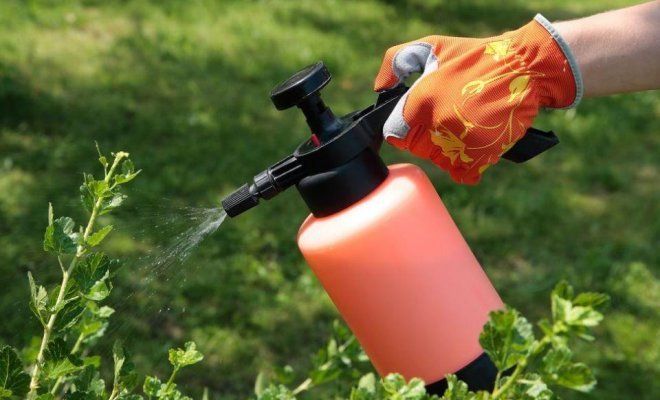

Spraying and processing trees
Important! When fruits appear or three weeks before harvest, spraying, as well as any other exposure to chemicals on the plant, must be stopped.
For the treatment to be effective, it is also recommended to remove mosses and lichens from the surface of the bark. By themselves, they do not pose any threat, but it is worth remembering that it is such an environment that is preferred for harmful microorganisms.
Correctly carried out whitewashing and spraying can reliably protect the plants, and taking into account the schedule and terms that are selected for each type of fruit plants will ensure a rich harvest. And even despite the fact that the procedures are still surrounded by a considerable number of stereotypes, the benefits they bring are undoubtedly higher.
How to whitewash trees in spring
Preparations for whitewashing trees
Garden whitewashing can be done with three compounds: lime mortar, water-based paint or water-dispersion paint. The composition of whitewashing for trees must necessarily include three components:
- white pigment - chalk or lime, since it is the white color that best protects the bark from the sun's rays;
- an adhesive base that fixes the pigment on the bark, preventing the composition from flowing down the trunk;
- fungicidal preparation that destroys infection in the cracks of the bark.
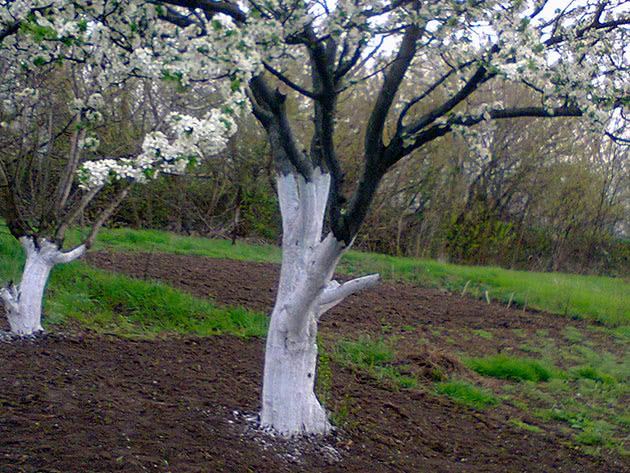

In the photo: Whitewashed apple trees
The easiest way to protect trees - lime or chalk solution, which gardeners have been using for a long time.There are several recipes in which the ingredients differ, but in any case, chalk or lime remains the basis. For example:
- in 10 liters of water, you need to dilute about three kilograms of slaked lime or chalk, add 500 g of copper sulphate and 100 g of casein glue, which can be replaced with a few tablespoons of flour paste. The composition is thoroughly mixed until all the ingredients are dissolved, then the whitewash should be infused for several hours;
- thoroughly mix in 10 liters of water 2 kg of slaked lime, a kilogram of greasy clay, a shovel of manure and 250 g of copper sulfate and leave to brew for 2-3 hours;
- in two liters of water, stir 300 g of fluffy lime, 2 tablespoons of copper sulfate, 200 g of stationery glue, 200 g of clay and 25 g of Karbofos;
- 400 g of copper sulfate should be dissolved in 2 liters of hot water and mixed with 100 g of casein glue, 2 kg of slaked lime and diluted with 8 liters of water.
Whitewashing has the disadvantage that its coating is quickly washed off or crumbled. That is why after the autumn whitewashing of trees with a lime or chalk composition, you will have to whitewash them again in the spring. If you use water-based or water-dispersion paints, then one whitewash per year, or even two, will be enough.
The main advantage of water-based paint is its durability: it forms a durable but vapor-permeable breathable coating on the barrel surface, which is resistant to washing off and sunlight.
- Norway maple: description of varieties, planting and care
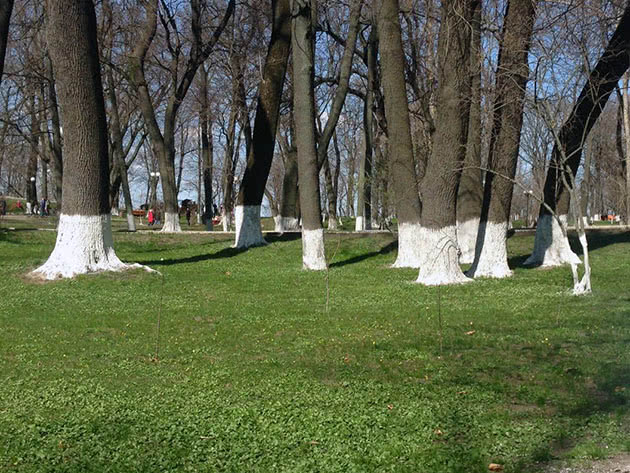

Photo: Whitewashed trees in the park
The composition of the water-dispersion paint, in addition to the pigment, includes latex and antiseptic. The paint forms a breathable coating on the tree trunk, but does not transmit ultraviolet rays, which can cause great damage to trees in spring. The water-dispersive coating lasts up to two years on the trunks, which greatly facilitates the work of the gardener. Painting of trees with a water-dispersion composition is carried out at an air temperature of at least 3 ºC.
How to prune trees in spring - tested by personal experience
Both water-based and water-based paints are sold in garden pavilions. But you can also independently prepare a durable paint by mixing two parts of a bustilate or PVA glue, one part of a pigment (chalk or kaolin) and adding a fungicidal preparation to the mixture.
How to dilute whitewash? After you mix all the ingredients well, add water in small portions to the mixture, continuing to stir the composition, so that in the end the consistency is as thick as oil paint.
Whitewashing tools
Most often, washcloth brushes are used to whitewash trees, but this is not the most convenient tool. It is easier and more convenient to use a swinging paint brush made of artificial material, as well as a flute brush, or a bristle brush, which allow one movement to cover a significant area of the bark surface, both smooth and fissured. If there are not many trees in your garden, then you will quickly manage with a brush or a paint roller, but if the garden is large and the trees are tall, then it is better to use a spray gun to whitewash them.
Preparation for whitewashing
Before starting whitewashing, the trunks must be prepared. This is a very important stage, it depends on how long the protective layer on the bark will last. If done correctly, it will take a long time to update. Preparation begins with cleaning the trunks from dirt and accumulated dust, from overgrown lichens and moss.
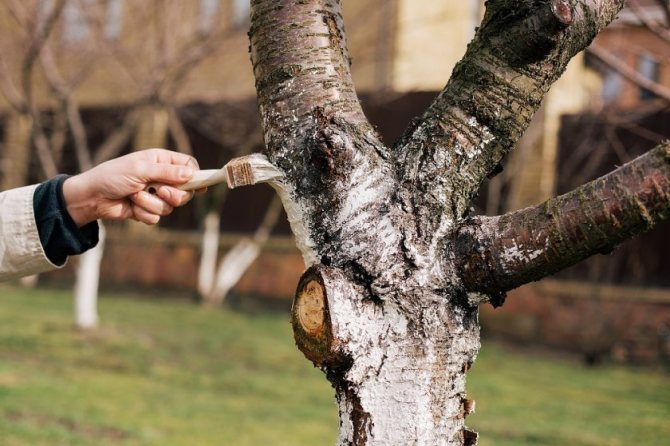

Photo: https://fermer.blog/media/res/6/5/1/5/2/65152.ppyqa0.840.jpg
Cleaning should not damage the bark, so the tools are carefully selected for it. A soft washcloth or a special soft washing glove is suitable. If the tree is very old, with bark that has already begun to flake off in places, some gardeners use metal brushes, carefully removing the top dried layer and taking care not to damage the living tissue of the trunk under it.
Disinfection of the trunk
Before starting cleaning, you need to spread the film in the near-trunk circles so that nothing falls on the ground. Then all the cleaned particles are collected and burned, since there are likely to be fungi and larvae of insect pests. Having got rid of debris, they proceed to disinfection. The point of the operation is to protect the exposed layers and close the appeared microcracks.
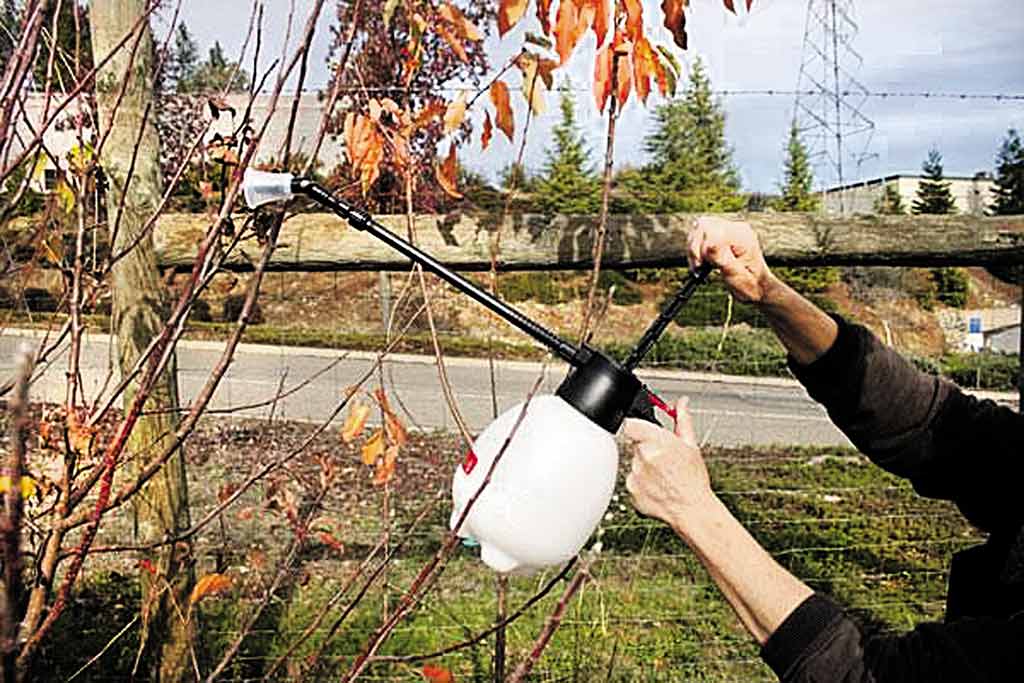

Photo: https://bgn.imadeself.com/wp-content/uploads/2018/11/u_listopadi.jpg
A solution of ash or laundry soap can be used as a disinfectant. Ash liquor can be used by boiling water together with ash and taking the liquid part after settling the sediment. Iron sulfate can be an excellent disinfectant, but it can accumulate in the bark, poisoning the tree. Therefore, you cannot use it every year.
Disinfection ends with the treatment of wounds left under the removed old bark. Each is covered with garden varnish, putties or garden pastes. And finally, you can start whitewashing, keeping the tree healthy.
The following two tabs change content below.
- Author
- Latest author posts
Pavel Markovich
All information on the site is created specifically for you to be aware of the latest most relevant news. And also so that it would be easier for you to engage in individual construction or simple repair of your apartment.
Spring whitewash composition
A prerequisite for any composition is its maximum reflectivity - whiteness! The best basis for whitewashing mature trees is freshly slaked lime. Its disinfecting properties are associated with obtaining an alkaline suspension. After drying, a strong CaCO crust forms on the trunk, which does not dissolve in water. The whitewash will last throughout the summer.
If it is difficult to find lumpy lime, you can use acrylic white paint, popularly called an emulsion.
These components are the basis of the whitewash composition for fruit trees. For better adhesion, 5 g of previously dissolved tar or laundry soap can be added to the bucket per 1 liter of suspension.
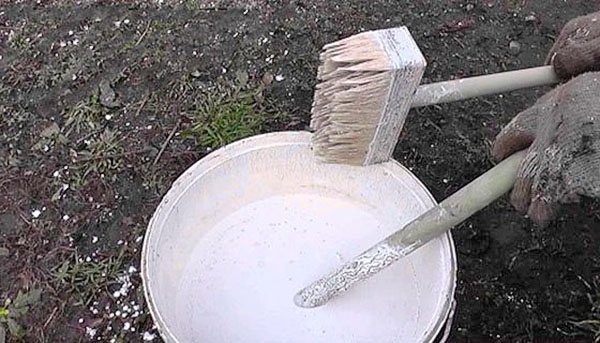

The rest of the components can be added as needed, based on 10 liters of solution:
- fresh manure 1 kg + copper sulfate 200 g;
- oily clay 1kg + fresh manure 1kg + copper sulphate 250 g.
You can add 100 g of karbofos or urea to the solution.
You shouldn't mix everything in one bucket. You need to focus on the population of the tree with pests. For young trees with thin bark without damage, the solution should be prepared on the basis of chalk. If you purchased a fluff, its disinfecting properties are weak, it has already decomposed in the air, you will need copper sulfate, karbofos, urea.
What whitewash protects from
The wood is adversely affected by heating. Moreover, the sun's rays do more harm in winter. The consequences of such an impact are a dehydrated top layer of the bark. The water balance is disturbed. The result is cracked bark. It is necessary to apply whitewash on time. She will play the role of protection.
Frosty weather acts on the bark in a similar way to the sun's rays. Here you can also solve the problem by whitewashing.
Processing saves trees from all kinds of pests (beetles, caterpillars, mice).
Before whitewashing, the trunk must be restored to its normal appearance. The main condition is that it should be wet outside. The bark must be freed from cracks, stratification, mosses, lichens. It is worth removing dead areas.
The best options for cleaning are wood and plastic items. Some people like to clean the bark with cloth gloves or sponges that have an abrasive surface. It is undesirable to use metal brushes, otherwise the barrel will be damaged.
After finishing cleaning, the barrel is disinfected. This process contributes to the destruction of pests, pathogens, decontamination of places with damage that occurred during processing. Disinfection is carried out when it is clear and dry outside.
The last thing to do is to cover up the wounds. To do this, use special tools - garden pitch or clay talker.
What materials are suitable for whitewashing trees in spring?
- Traditionally, slaked lime was used as a whitewash.
Despite its low cost, this material has many disadvantages: in addition to the fact that high concentrations of lime can harm the young bark of a tree, lime has to be applied to mature trees several times, reaching a certain thickness of the coating.
Typically, a concentration of 1 kg of hydrated lime dry mixture per liter of water was used. As a result, you should get a consistency reminiscent of liquid kefir. They also resorted to some tricks in order to increase the thickness of the layer and prevent washing off by sediments: PVA glue or soap was added to the slaked lime.
- Another, more effective recipe, based on slaked lime:
- 2 kg of slaked lime, 100 grams of casein glue, 500 grams of copper sulfate (dissolved in hot water). These ingredients are placed in a 10 liter bucket and diluted with water to a semi-liquid consistency. This formulation is water-resistant and gives a dense, one-coat finish.
- In a bucket with a volume of 10 liters, mix 2-3 kg of slaked lime, 0.5-1 kg of clay (oily), 1 kg of manure and 400 grams of copper sulfate. The mixture should stand for a couple of hours before use.
- Ready mixes from garden supply stores
- Water-based or water-dispersible paint. A durable coating that protects the bark of the tree from possible damage and disease, does not clog the pores of the bark, and is resistant to washing off and sunlight.
